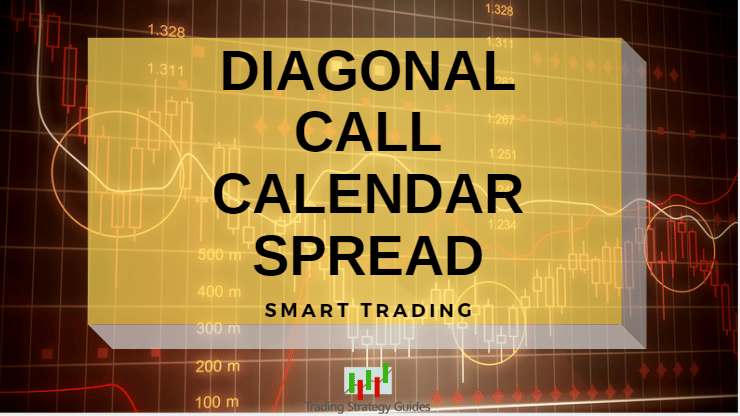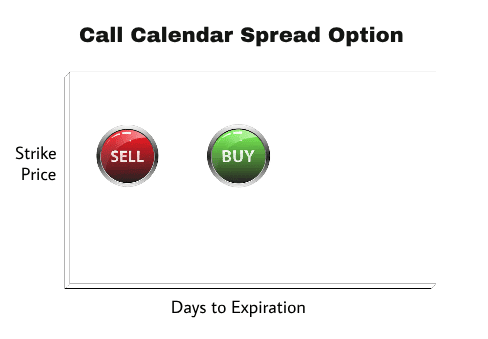Diagonal Call Calendar Spread – Smart Trading

If you want to take advantage of short-term weaknesses that will revert in the end, the diagonal call calendar spread will help you make smarter trades. In this trading guide, we’re going to discuss how to setup and trade with the call calendar spread strategy.
If this is your first time on our website, our team at Trading Strategy Guides welcomes you. Make sure you hit the subscribe button to get a Free Trading Strategy every week directly into your email box.
This options strategy is an advanced strategy that profits from both the decay in the option prices and the differential between the contract months and the downward directional movement of the underlying stock.
Usually, a spread can be constructed with either puts or calls. However, throughout this options trading guide, we’re going to learn how to take advantage of the calendar spread using calls.
Options are great instruments because they offer a lot of flexibility. In order to reveal the full power of options trading, you’ll need to educate yourself. This options trading guide will help you get started with more advanced options strategies that can get trickier if they are misunderstood.
Below, we will review how to construct a calendar spread using calls.
Diagonal Call Calendar Spread
To better understand the diagonal call calendar spread, an option spread is constructed by buying an option and selling the option of the market at the same time.
For simplicity, you can think of the calendar call spread as a two-part option strategy:
- Sell 1 out of the money front month call
- Buy 1 out of the money back month call, at a higher month strike price
A diagonal spread has both different months and different strike prices.
The front-month option should only be about 20 to 45 days out. We don’t want to get closer or longer than that. The difference between the calendar call spread option strategy and the regular calendar spread is that we’re going to go to a higher strike price for the back month option.
We’re trading two different contract months, both the front-month call and back month call, and we’re trading two different strike prices.
Use this options trading guide as your resource when you are constructing a long call calendar spread.
Below, we outline how you’ll need to play with the call calendar spread strategy. Also, read the Iron Condor Options Trading Guide here.
Call Calendar Spread Strategy
In this section, we’re going to talk about what a long call calendar spread is and how to construct a call calendar spread strategy. Last but not least, we’re going to break down some call calendar spread examples.
How a long call calendar spreads work?
The long call calendar spread is an options strategy that involves simultaneously buying and selling two options of the same type, with the same strike price, but using different expiration months. When we have a call option strategy that involves the same strike price we refer to it as the horizontal spread.
Typically, a long calendar spread using calls is created by buying one long-term call option and simultaneously selling one short-term call option.
The easiest way to remember the difference between a vertical spread and a horizontal spread is as follows:
- If we have the same strike price, it’s a horizontal spread.
- If we have different strike prices, it’s a vertical spread.
In terms of vertical spreads, everything is the same except the strike prices. In a horizontal spread, the only difference is the expiration date.
Typically, traders will use the standard monthly cycle. For instance, you can construct a calendar call spread option strategy by selling a call option in the nearest standard monthly expiration cycle and then buying the same call option with the same strike price in the next month’s expiration cycle.
Before moving forward, let’s quickly visualize the difference between a vertical spread and a calendar spread.
Now, let’s see how you can profit from buying two call options with the same strike price, but different expiration months.
After seeing this call calendar spread example, you’ll understand exactly how the calendar call spread option strategy works. We’re going to break down a historical calendar spread’s component relative to changes in the stock price.
See below:
Call Calendar Spread Examples
Let’s assume the call calendar spread strategy has the following details:
- The ABC stock price at entry is trading at $150.45
- To construct the long call calendar spread we’re going to go ahead and:
- Sell the $150 call option with 30 days to expiration
- Buy the $150 call option with 80 days to expiration
As you can tell, when we construct the long call calendar spread, everything is the same except the expiration date of the two options.
The calendar spread entry price is calculated as the price of the call option we bought minus the call option we sold. Going further with our example, we’re going to assume that we’ve paid the following amounts for the two call options:
- Sold the 30 days call option for $4.50
- Bought the 80 days call option for $6.65
This brings our call calendar spread entry price to:
$6.65 Paid – $4.50 Collected = $2.15 Paid
When you buy a calendar spread, you’re basically anticipating that the stock price will remain somewhere near the strike price of the calendar spread by the expiration time.
In our call calendar spread examples, we purchased the $150 call calendar spread, which means we want the stock price to gravitate closer to $150 as time passes.
Let’s take a look at different trading scenarios. We will see how the calendar spread price changes with the stock price changes.
See figure below:
On the top part of the above graph, we’re looking at the changes in the stock price relative to the calendar strike price. At the bottom part of the graph, we can see the price of the long $150 call calendar spread. Also, be sure to check out our Covered Call Strategy.
As we can see in this call calendar spread example, as time passed, the stock price hovered around that strike price of $150. As such, the calendar spread price also increased from the entry price of $2.15 all the way up to a price of $3.10.
Why did the calendar spread price increase?
Over time, the calendar spread increases because the short call option price decreases at a faster rate than the long call option price. Because the short option lost more of its value than the long option, the calendar spread price increases.
This may not make sense just yet, so to be sure, we’re going to look at the math behind the calendar spread price. As a reminder, the price of a long call calendar spread is calculated by subtracting the price of the short option from the long option.
At the time of the near-term call expiration date, the price of the short call was $1.50, which is $3.00 less than we sold it for. The long call price was $4.60, which is $2.05 less than we purchased that call for.
Near-term options decay at a fast pace than long-term options which is why the long calendar spread increased from the entry price, helping us to generate a profit.
Conclusion – Calendar Spread Using Calls
In summary, calendar spread using calls will generate profits over time because the decay of the short option is more significant than the decay of the long option. The long calendar spreads are often considered to be long volatility trades. In order to maximize the profits of the call calendar spread strategy, one must forecast the strike price to be the same on the expiration date of the short call option.
The diagonal call calendar spread is a more complex option strategy dedicated to the more advanced traders. The paradox behind this strategy is that you need the price of the stock to be relatively stable, but you also want some volatility in-between the expiration dates so you can profit from the diagonal call calendar spread.
Above all, to successfully run these options strategies, you also need a good understanding of risk management.
Thank you for reading!
Feel free to leave comments below, we read all of them and will respond.
Also, please give this strategy a 5 star if you enjoyed it!
[ratings]
Please Share this Trading Strategy Below and keep it for your own personal use! Thanks Traders!












